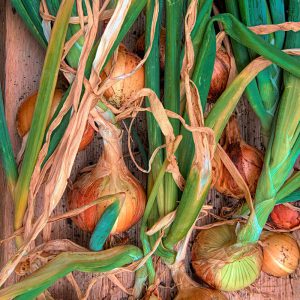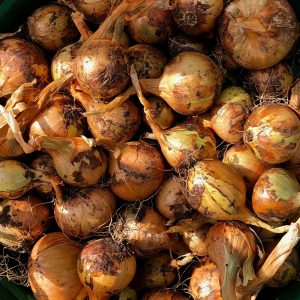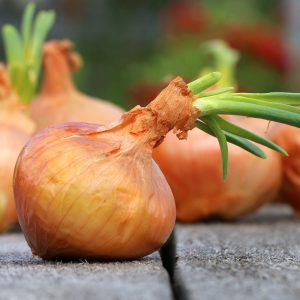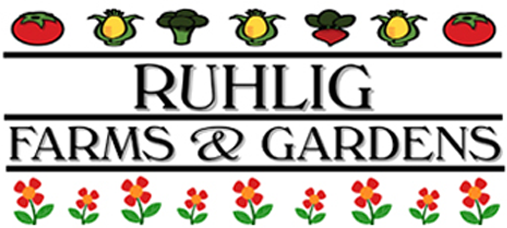Onions are arguably the most widely used vegetable worldwide, with over 20 billion pounds grown yearly. More often than not, onions are used to flavor food rather than eaten alone. They are the perfect addition to all sorts of savory dishes in just about every culture. In recipes, the bulbs may be used whole, sliced, diced, chopped, minced, grated, and even powdered. They are consumed raw, fried, sauteed, grilled, broiled, boiled, and roasted. Not only are they delicious, but there are also health benefits to eating onions. They possess potent anti-inflammatory properties, are high in vitamin C and B6, and are a great source of potassium. Although the bulb is most commonly consumed, all parts of the onion plant are edible, including green leaves and flowers.
Why Grow Your Own
Onions are easily affordable and readily available at the local grocery, so why grow your own? Well, for one, they taste better, much better! Convenience is another reason; you can have onions easily accessible at various stages throughout the growing season and beyond. Onions are also great companion plants. Frequently planted alongside or interspersed with members of the cabbage family, beets, carrots, cucumbers, eggplants, lettuces, peppers, potatoes, squashes, tomatoes, and zucchinis to repel a number of garden pests.
Selection
Onions are available in an almost unlimited number of varieties. There are white, yellow, and red onions. They may have a pungent flavor, a sweet taste, or anywhere in between. There are small, medium, and large onion sizes. Scallions, green onions, or bunching onions are harvested and eaten when still immature before the bulb has formed. There are short-day (southern gardens), long-day (northern gardens), and day-neutral (mid-section America gardens) onion varieties. Your local garden center will advise which are best for your area. Personal preference and anticipated usage will help narrow your selection further.
Onions may be grown from either seed or sets. It takes a great deal of time to grow onions from seed; therefore, they should be started indoors early. Onion sets, highlighted in this article, are a quick and easy way to start onions, recommended for both the beginner and experienced veggie gardener. Sets consist of tiny onions that are to be planted directly into the soil and mature in about 14 weeks. When purchasing your sets, it is important to keep in mind that bigger is not better. The maximum size of the bulbs should be no greater than ¾ of an inch. Larger size bulbs tend to have several associated problems that can lead to grower disappointment.
Preparing
Onions must be planted in a full-sun location. In the north, onion sets should be planted in the spring as soon as the soil is workable and not too wet. In the south, they may be planted in the early fall. Onion sets may be planted directly in the garden, raised-beds, or containers, but they must have loose, fertile, well-drained soil.
Poor soil? No problem! Ruhlig Farms & Gardens has you covered with convenient, bagged, premium soils and soil amenders!
To prepare your garden when planting onions:
- In-ground beds
Till native soil to at least 1 foot deep, removing all rocks and debris, and evenly spread at least 4 inches of high-quality compost atop the soil surface and till again; this is best done in the fall.
- Raised-beds
Soil should be loosened with a garden fork to a depth of 1 foot. Evenly spread at least 4 inches of high-quality compost atop the soil surface and turn into the bed. This is best done in the fall.
- All Containers
Fill containers with high-quality potting soil amended with plenty of compost. Make sure that containers have adequate drainage holes to prevent rot.
Onions are heavy feeders. When amending the soil in garden beds and filling containers, incorporate a balanced, slow-release, organic fertilizer recommended for vegetables; this will get onions, and all of your garden veggies, off to a good start.
Planting
When planting onion sets directly into the ground and in raised-beds, create furrows about 2 inches deep and 3 inches wide. Rows should be no closer than one foot apart. Place about an inch of high-quality compost in the bottom of the furrow. Gently place the small onions 6 inches apart, pointed side up, and press lightly into the compost at the bottom of the furrow. Backfill with remaining soil. Simply a smaller growing space, this same planting process should be followed when growing onions in containers.
Growing
Onions grow best with about an inch of water a week. If there is a shortage of rain, supplemental water must be provided. Mulching between the rows will help the soil retain moisture and aid in keeping weeds at bay. Fertilize onions monthly by side-dressing with a balanced, slow-release, organic fertilizer recommended for vegetables
Harvesting, Curing, & Storing
Harvest onions as needed; they may be eaten at any stage. For winter storage, harvest time is here when the onion leaves turn yellow and fall over. You should see the top of the bulb crowning the soil, signifying that the bulb is mature. All onions should be taken up before the first frost. Either pull the plants by hand or use a garden fork to dig them out of the ground.
To cure onions for storage, lay them out in a single layer in a warm, dry, well-ventilated location until the necks are completely dry and the stem contains no more moisture. At this time, with a clean, sharp pair of scissors, cut the leaves and roots off of the bulb and gently place them in a bushel basket or mesh bag.
Onions are best stored in a cool, dark location like a root cellar, basement, or garage that will not freeze. The air temperature should be maintained around 35 to 40 degrees Fahrenheit. Some onions store better than others. The best will maintain their quality for up to 12 months.
Tip
If, by chance, an onion begins to bolt and throws up a flower stalk, immediately cut off the stalk and use the onion as soon as possible. Flowering changes the taste of the onion, making it unpleasant, and an onion that has bolted will not last in storage.
Ruhlig Farms & Gardens is available to answer all your vegetable gardening questions. All you have to do is ask.



